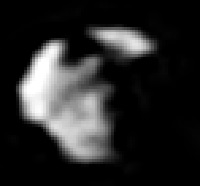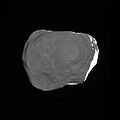Helene (moon)
| Helene | |
|---|---|

|
|
| Saturn's moon Helene in front of Saturn, recorded by the Cassini-Huygens space probe | |
| Provisional or systematic name | S / 1980 S 6 |
| Central body | Saturn |
| Properties of the orbit | |
| Major semi-axis | 377,420 km |
| Periapsis | 374,740 km |
| Apoapsis | 380,100 km |
| eccentricity | 0.0071 |
| Orbit inclination | 0.21 ° |
| Orbital time | 2.737 d |
| Mean orbital velocity | 10.03 km / s |
| Physical Properties | |
| Albedo | 0.6 |
| Apparent brightness | 18.4 mag |
| Medium diameter | (35.2 ± 0.4) km |
| Dimensions | ≈ 11 · 10 15 kg |
| Medium density | ≈ 0.5 g / cm 3 |
| Sidereal rotation | 2.737 days |
| Axis inclination | 0 ° |
| Acceleration of gravity on the surface | ≈ 0 m / s 2 |
| Escape speed | ≈ 0 m / s |
| discovery | |
| Explorer | |
| Date of discovery | March 1, 1980 |
| Remarks | Bound rotation |
Helene (also Saturn XII) is a small (the seventeenth largest) moon on the planet Saturn .
discovery
Helene was discovered on March 1, 1980 by the astronomers Pierre Laques and Jean Lecacheux at the observatory on the Pic du Midi in the French Pyrenees . It was initially given the provisional designation S / 1980 S 6 . In 1988 she was officially named after Helen of Troy , a granddaughter of Kronos , to whom Saturn corresponds in Roman mythology .
Orbit data
Helene orbits Saturn at an average distance of 377,420 km in 65 hours and 41 minutes. The orbit has an eccentricity of 0.0071 and is inclined 0.21 ° to the equatorial plane of Saturn.
It is one of two small moons on the orbit of the great moon Dione . Helene runs ahead of Dione at an angular distance of 60 ° in the leading Lagrangian point L 4 . In the following Lagrangian point L 5 , the moon Polydeuces Dione follows at an angle of 60 °.
Before she got her official name, Helene was commonly referred to as "Dione B".
Structure and physical data
Helene is an irregularly shaped body with an extension of 36 × 32 × 30 km. Its low density of 0.5 g / cm 3 indicates that it is mainly composed of water ice and a small amount of silicate rock.
Helene rotates around her own axis in 65 hours and 41 minutes and thus shows a bound rotation like the Earth's moon . It has a light surface with an albedo of 0.6, i.e. That is, 60% of the incident sunlight is reflected . Seen from earth, it is an extremely faint object with an apparent brightness of 18.4 m .
gallery
Helene sickle , taken by Cassini on March 3, 2010
Individual evidence
- ^ Cassini Solstice Mission - About Saturn & Its Moons: Helene ( Memento from April 21, 2014 in the Internet Archive ), NASA
Web links
- IAUC 3457: Saturn March 6, 1980 (discovery)
- IAUC 3872: Satellites of Jupiter and Saturn September 30, 1983 (numbering)
- IAUC 4609: Satellites of Saturn and Uranus June 8, 1988 (numbering and naming)
- Cassini Solstice Mission: Helene
- NASA Solar System Exploration - Helene: Facts & Figures (dead link)
- JPL - Planetary Satellite Physical Parameters
| further inside | Saturn moons | further outside |
| Dione |
Semi- major axis (km) Helene 377.400 |
Polydeuces |







